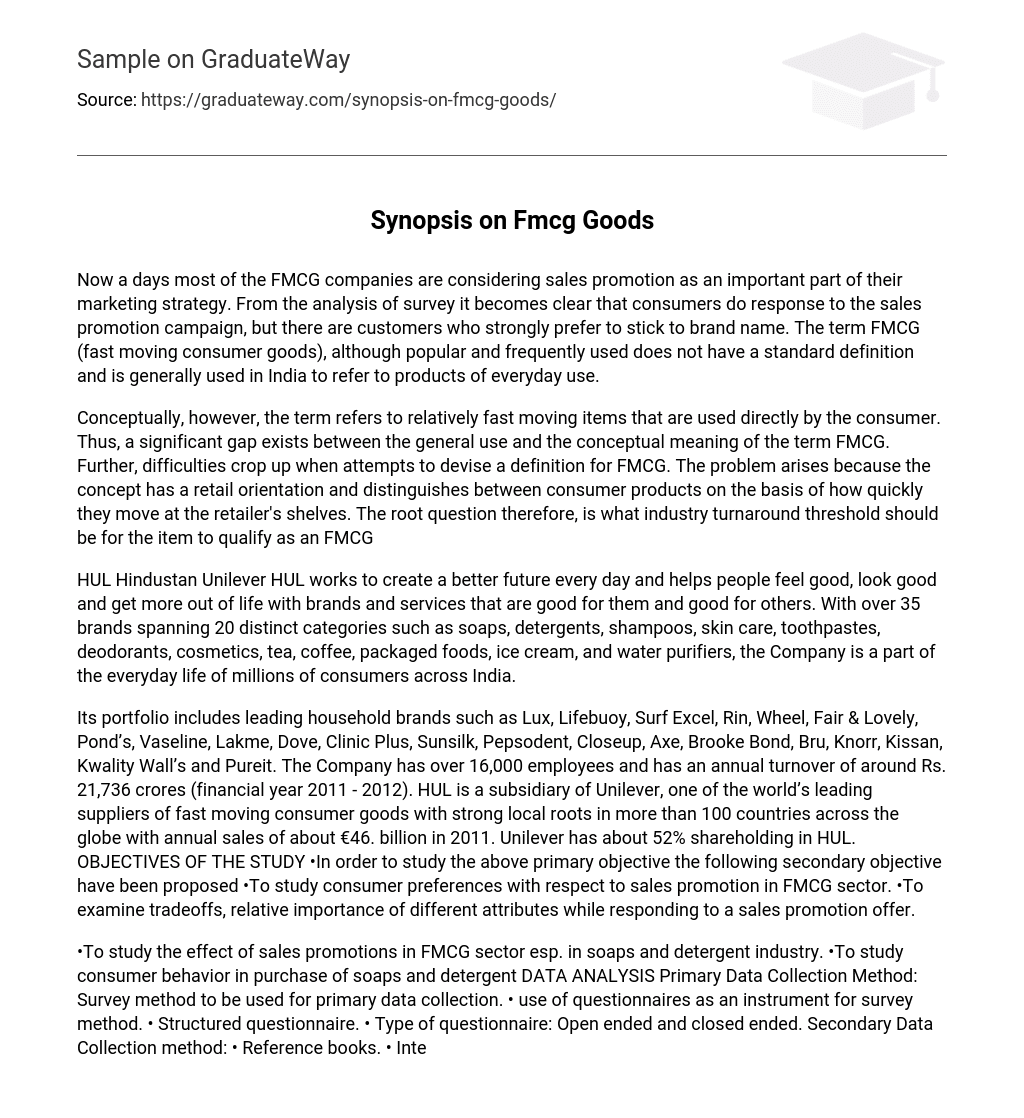Many FMCG companies consider sales promotion an important part of their marketing strategy. Survey analysis shows that consumers do respond to sales promotion campaigns, although some customers remain loyal to specific brands. In India, the term FMCG (fast moving consumer goods) does not have a standardized definition and is commonly used for everyday products.
The term FMCG refers to items that are used directly by the consumer and move quickly. However, there is a gap between the general use and the conceptual meaning of FMCG. Defining FMCG proves challenging due to its retail orientation and the distinction it makes between consumer products based on their speed of movement on retailer shelves. The main question is what industry turnaround threshold an item should meet to be considered an FMCG.
HUL (Hindustan Unilever) strives to enhance people’s lives and wellbeing by offering a diverse range of products and services. This includes soaps, detergents, shampoos, skincare items, toothpastes, deodorants, cosmetics, tea, coffee, packaged foods, ice cream, and water purifiers. HUL has become an essential aspect of millions of Indian consumers’ daily routines.
The text highlights that the portfolio of this company comprises renowned household brands including Lux, Lifebuoy, Surf Excel, Rin, Wheel, Fair & Lovely, Pond’s, Vaseline, Lakme, Dove, Clinic Plus, Sunsilk, Pepsodent, Closeup, Axe, Brooke Bond, Bru, Knorr, Kissan, Kwality Wall’s and Pureit. The company has more than 16,000 employees and achieves an annual turnover of approximately Rs. 21,736 crores (financial year 2011 – 2012). HUL operates under Unilever, a prominent supplier of fast moving consumer goods globally. Unilever’s sales in 2011 totaled around €46 billion and it holds a 52% share in HUL. The study aims to explore consumer preferences in the FMCG sector and evaluate the tradeoffs and relative importance of different attributes in response to sales promotion offers.
The aim of this study is to investigate the effects of sales promotions in the fast-moving consumer goods (FMCG) industry, specifically in the soaps and detergent sector. Additionally, it seeks to analyze consumer behavior when purchasing these products.
Regarding data analysis, the primary method of collecting information will be through surveys. Questionnaires with a combination of open-ended and closed-ended questions will serve as the main tool for this survey method.
Secondary data will be obtained from reference books and online sources.
For sampling purposes, the target population consists of Hyderabad residents. Individual consumers will be chosen as sampling units, with a sample size of 100 consumers and 100 retailers selected using convenience-sampling methodology.
Characteristics of FMCG Products • The value of individual items is small, but when combined, FMCG products make up a significant portion of a consumer’s budget. • Consumers typically keep a limited inventory of these products and prefer to buy them frequently as needed. Many of these products are perishable. • Consumers do not spend much time making purchase decisions and often do not look for technical specifications like industrial goods. Purchase decisions are often influenced by brand loyalty or recommendations from reliable retailers. Advertising, retailer recommendations, and word-of-mouth can also induce brand switching and the trial of new products. • FMCG products cater to necessities, comforts, and luxuries, serving various segments of the population. Price and income elasticity of demand vary among different products and consumers. Consumer sales promotion has become increasingly important in the global marketing mix for FMCG products, leading companies to dedicate significant time to plan such activities.
Enhancing the effectiveness of promotional activities requires manufacturers to grasp how consumers and retailers perceive them. This research primarily examines how consumers view sales promotion and its impact on brand value. Promotions provide utilitarian advantages such as cost savings, increased value, better quality, and convenience. Additionally, they offer hedonic benefits like entertainment, exploration, and self-expression. These benefits encompass the four essential elements of the marketing mix.
Marketing strategies often revolve around promotion, a crucial component of the overall marketing mix. Promotion encompasses various elements such as advertising, direct marketing, public relations, and sales promotion. Historically, marketers have utilized sales promotions to drive short-term sales. However, this communication tactic has evolved into a strategic approach in recent years. Consequently, it is imperative to conduct fresh research in this area to analyze how consumers evaluate sales promotions.
Sales promotions have become more important and frequent in recent decades. While there is no exact figure for total sales promotion spending, we can be certain that it is increasing. Sales promotion plays three crucial roles: informing, persuading, and reminding potential customers about a company and its products. Even the best product or brand will fail if nobody knows it exists. Distribution channels require more time to create awareness as a product must pass through many intermediaries before reaching consumers.
Therefore, it is necessary for a producer to communicate information about the attributes and availability of their products to both channel members and ultimate consumers. Additionally, promotion serves the purpose of persuasion, as fierce competition forces manufacturers to engage in sales promotion activities. Furthermore, promotion also serves the purpose of reminding consumers about the availability of products and their ability to meet their needs. This project specifically focuses on the element of Sales Promotion.
Further Sales Promotion encompasses both Consumer Oriented Sales Promotion and Trade Oriented Sales Promotion. The tools used for achieving the objective of sales promotion are varied and should be selected based on factors such as cost, time, competition, and availability of goods. The following tools are commonly employed:
- Coupons
- Price-Off
- Freebies
- Scratch Cards
- Lucky Draws
- Bundling Offer
- Extra Quantity





